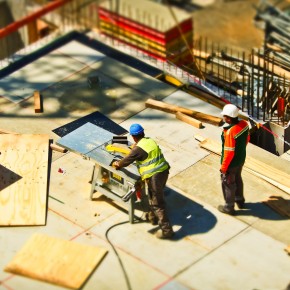
GUEST ARTICLE: Innovation in construction – utilising non-traditional materials
Leanne Thompson takes a look at how non-traditional materials can be used in construction for innovation.
Assisted by the good weather, the UK construction industry has recovered better than expected in 2018. This has lead to an increase in the amount of construction materials purchased. According to a report in The Guardian, this suggests that the previous downturn could have been due more to the grim weather of last winter than to any ongoing malaise in the construction industry.
This is good news for an industry which is looking towards innovation in materials, to help make its processes and projects more cost effective and sustainable; a move that can only make a healthy future more likely. According to the professionals at Provincial Rubber, “A wide range of sheeting materials that can resist the pressures of different environments can only be beneficial to the construction industry”. Developments do not stop there, many different non-traditional materials and processes are laying the foundations for the future of the construction industry.
3D printed concrete
Theoretically, you could see an iconic skyscraper being constructed by 3D printing concrete, at some point in time. In reality, this technique is more likely to be useful in smaller elements of construction, at least in the immediate future. That being said, some 3D printed structures already exist, such as the first footbridge to be made using the method which stands in the Castilla-La Mancha park, in Alcobendas, Madrid. The construction of this bridge shows that 3D printed concrete can be used to create unusually shaped structures that would be difficult to produce using other methods. This method of using concrete in construction also reduces wastage, as only the exact amount of concrete to be used is produced.
Concrete that heals itself
You may not think that the development of VELCRO has very much to do with the future of concrete, but there is a link. They are both centred on the idea of biomimics; materials that are created to mimic nature or by making use of features that exist in nature. VELCRO was inspired by the way plant burrs attached the fur of a dog. Self-healing concrete is inspired by the use of naturally occurring items, such as fungus that produces limestone. The items are added to the concrete. This addition helps the concrete to fix any fine cracks that appear, without the need for human intervention.
Photovoltaic glass
Building integrated photovoltaic (BIPV) technology is one of the biggest developments for the construction industry, when it comes to materials. The material can be used to turn an entire building into a solar panel as it can be used to create windows, roofs and facades. These areas of the building can be double glazed and insulated at the time of construction. The cost of using BIPV is not far in excess of using normal glass, when you take into account the fact that additional measures to clad, or provide shade for, a building are not necessary.
Wood that is super strong
Wood has been a popular construction material for centuries. It’s a readily available resource and it has a positive effect on the appearance of buildings. Some wood, such as oak, is known for its strength. The same cannot be said for all wood; or can it? The recently developed technique of creating super wood means that all wood can be strengthened and made resistant to pests and moisture. The technique involves treating the wood, using a similar method to the way wood pulp is produced. The wood is then compressed and treated with heat. This treated wood can be moulded into different shapes and becomes significantly harder than natural wood while also being scratch resistant.
Asphalt that protects the environment
Asphalt already had a positive effect on the environment, with the use of recycled rubber in its creation. Today, more work is being done on using other items in the mix; to help make the world a cleaner, and more sustainable, place. Items that could potentially be added include recycled plastic and cigarette butts. The latter of these additions may sound unlikely, but cigarette butts can apparently improve the safety of road surfaces. This idea of adding other items to asphalt seems set to be a main consideration in the future of construction.
Although the construction industry in the UK seems to be recovering from the dip that it experienced during last winter, it needs to remain competitive. It’s this consideration, together with the need to protect the environment, that is leading it to embrace the use of non-traditional materials and practices.
Latest news

11th April 2025
Don’t Do a Dave! It’s Time to Lock FIT Show 2025 in Your Calendar!
It’s that time again – FIT Show is back! You could be forgiven for thinking there won’t be much new to see when FIT Show returns to the NEC from 29 April – 1 May. Wrong!
Posted in Articles, Building Industry Events, Building Industry News, Building Products & Structures, Building Services, Continuing Professional Development (CPD's), Exhibitions and Conferences, Information Technology, Innovations & New Products, Restoration & Refurbishment, Retrofit & Renovation, Seminars, Training
11th April 2025
Insight Data: Boost construction success with project and prospect data
For those working in construction – in whatever capacity – the last few years haven’t been much fun. And according to the latest statistics, it would seem the challenges are continuing – Alex Tremlett, Insight Data’s Commercial Director, has more…
Posted in Articles, Building Industry News, Building Services, Information Technology, news, Research & Materials Testing
11th April 2025
ASSA ABLOY EMEIA: Learn how to tackle the security challenges of digitalising access with insights from industry experts
In a new series of videos, experts in various specialisms within ASSA ABLOY share their expertise on digital access, including the complexities to overcome and the range of benefits for those who get digital access right…
Posted in Access Control & Door Entry Systems, Architectural Ironmongery, Articles, Building Industry News, Building Products & Structures, Building Services, Doors, Facility Management & Building Services, Information Technology, Innovations & New Products, Posts, Restoration & Refurbishment, Retrofit & Renovation, Security and Fire Protection, Videos
10th April 2025
Geberit completes 150 Acts of Kindness
Geberit has raised nearly £14,000 for various charities through its ‘150 Acts of Kindness’ initiative, a year-long programme of fundraising and volunteering to mark the company’s 150th anniversary in 2024.
Posted in Articles, Bathrooms & Toilets, Bathrooms, Bedrooms & Washrooms, Building Industry Events, Building Industry News, Building Products & Structures, Building Services, Charity work, Drainage, Interiors, Pipes, Pipes & Fittings, Plumbing, Restoration & Refurbishment, Retrofit & Renovation
 Sign up:
Sign up: 